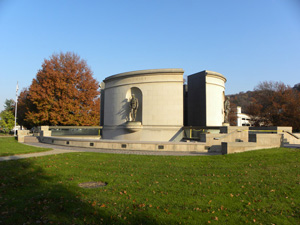

Remember...
Woodrow Wilson Barr
1913-1942
"We will fight our country's battles in the air, on land, and sea."
 |
Remember...Woodrow Wilson Barr
|
Marine Private First Class Woodrow Wilson Barr hailed from Keyser, West Virginia. Born on June 30, 1913, and named for the U.S. president, he was the son of James Arthur Barr (1883-1940; son of Annabelle Ross Foreman and Mahlon Harvey Barr) and Cora Dell Propst Barr (1885-1961; daughter of Angeline Hansford and George L. Propst), both long-time residents of Mineral County. The 1920 Federal Census shows the family living in Logan County, and lists Woodrow's siblings as Clarence A., Marguerite W., James O., Paul, Buster, Arthur, and Opal Marie.
At some point, the family returned to Mineral County, but Woodrow Wilson Barr graduated from Parsons High School (Tucker County). Like many of his contemporaries from the eastern part of the state, Woodrow found employment in nearby Maryland, where he worked at the Celanese plant in Cumberland for four years prior to his service in World War II. He was a Protestant by faith.
Woodrow Wilson Barr entered the Marine Corps on January 13, 1942, and received his training at Parris Island, followed by a stint at Quantico. Assigned to the 1st Marine Raider Battalion, 4th Marine Regiment, 1st Marine Division:he was promoted to private first class on May 1:in his short seven months in the Corps he served at Guadalcanal and Watchtower and later at Tulagi in the Solomon Islands. It was here he was one of forty-five Marines killed in action as the U.S. recaptured that island from the Japanese on August 7, 1942. Pfc. Barr received the Silver Star (for "conspicuous gallantry and intrepidity in action") and the Purple Heart, posthumously, in addition to the Presidential Citation (1942) and the Asiatic-Pacific Campaign Medal (1942).
The Guadalcanal-Tulagi Invasion of August 7-9, 1942, just over a half year into the U.S. involvement in the Pacific Theatre, was led by an assault force of thirteen big transports, six large cargo ships, and four small high-speed transports manned by some 19,000 Marines and backed up by three aircraft carriers, a battleship, six cruisers, sixteen destroyers, and five oilers. Vice Admiral Frank Jack Fletcher commanded the entire operation. While most of these ships were intended to assault Guadalcanal, Tulagi, just twenty miles away and to the north, was a strategic target as well. Although the Marines achieved their invasion objective relatively quickly in this recapture, supply shortages over the next few weeks made their efforts to hold their territory tenuous. (Source: "Guadalcanal-Tulagi Invasion, 7-9 August 1942," Naval History and Heritage Command, accessed February 27, 2012, http://www.history.navy.mil/photos/events/wwii-pac/guadlcnl/guad-1.htm.) It was in this campaign that Pfc. Woodrow Wilson Barr lost his life when he persisted in his advance against a hostile machine-gun position.
Mary P. Walker, in her article "Barr" in the Dictionary of American Naval Fighting Ships (DANFS), tells the story of the Buckley class destroyer escort (DE 576) named for Woodrow Wilson Barr. Built at Hingham, Massachusetts, by the Bethlehem Shipbuilding Company; launched on December 28, 1943; and commissioned on February 16, 1944, the Barr was sponsored by Pfc. Barr's mother, Coral Dell Barr, and commanded by Lt. Comdr. Henry H. Love. The Barr first reported for antisubmarine duty off the Cape Verde Islands and was part of a group that verified German submarine action in the South Atlantic. While pursuing U 549 on May 29, the Barr was hit by a torpedo. With the wounded and half of the crew evacuated that night, the destroyer escort was towed into port at Casablanca, Morocco, six days later.
After refurbishing, the Barr was converted to a high-speed transport (APD 39) and relocated to the Pacific. In Hawaii (1945), the ship trained with Underwater Demolition Teams that were preparing for the invasion of Iwo Jima. With that island secured, the Barr then became part of the invasion of Okinawa. After the surrender of Japan, the ship was used to evacuate Allied prisoners from the Japanese islands.
In late 1945 and early 1946, the Barr returned to the States, ultimately landing in Green Cove Springs, Florida, where she was placed out of commission, in reserve. The ship remained in this status until June 1, 1960, when she was struck from the Navy list. The Barr was sunk as a target off Vieques Island (near Puerto Rico) on March 26, 1963. (Source: Naval History and Heritage Command, accessed February 21, 2012, http:www.history.navy.mil/danfs/b2/barr-i.htm.)
Pfc. Woodrow Wilson Barr's remains were returned to the States, where he was interred at Queens Meadow Point Cemetery at Keyser in Mineral County.
In 2012, the West Virginia Legislature named a bridge over Patterson Creek on U.S. Route 50 in Burlington, Mineral County (Bridge number 29-50-18.78), for this much-decorated veteran. Although the ship bearing his name is but a distant memory, the USMC PFC Woodrow Wilson Barr Memorial Bridge will serve for many years to come as a reminder of this man's heroic actions.
Article contributed by Patricia Richards McClure, who gratefully acknowledges the assistance of WV Delegate Gary Howell of Mineral County.

West Virginia Archives and History welcomes any additional information that can be provided about these veterans, including photographs, family names, letters and other relevant personal history.